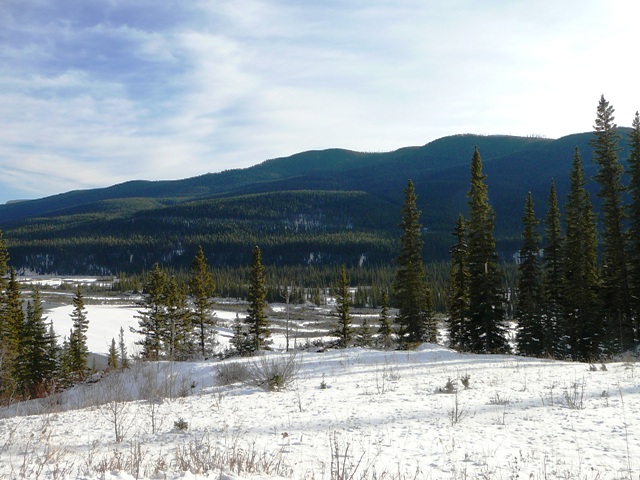OBJECTIVES-
This proposal focuses on mechanisms driving population cycles of the Canadian lynx in southern portions of their range by evaluating the predator dispersal versus the seasonal-forcing hypothesis (see lynx ecology page). The objectives are to 1) regionally document the 10-year cycle break down at southern latitudes, 2) evaluate barriers to gene flow (hence dispersal) across a latitudinal gradient, 3) use radiocollared lynx to create a robust GIS-based model of habitats that facilitate dispersal into the southern portions of the species’ range, and 4) examine timeseries dynamics relative to climate data to evaluate the seasonal-forcing hypothesis.
METHODS-
To quantify the breakdown of the lynx cycle on a fine scale (objective one) trappers’ harvest data will be compiled for Alberta, BC, Yukon, and NWT from the Hudson’s Bay Company Archives prior to1950 and provincial registered fur management areas (traplines) between 1950 and 2006. We will aggregate harvest data among adjacent areas having similar dynamical patterns based on Moran’s I (Moran 1950) and analyze the north-south gradient using timeseries methods organized spatially in a geographical information system (GIS).
Evaluating dispersal barriers using genetics (objective two) will require gathering tissue samples during the 2007-08 Alberta and BC trapping seasons (small samples of skin removed harvested lynx pelts). We will use 20 microsatellite loci effective in genotyping lynx to quantify the geneflow across southern portions of the range (Campbell & Strobeck 2006, Schwartz et al. 2002, Rueness et al. 2003). Genetic structuring of the population will be characterized using STRUCTURE software. We will analyze isolation at the individual level using spatial autocorrelation procedures (Cushman et al. 2006).
The third step involves radiocollaring a sample of 20 lynx in the Central Eastern Slopes area of the Rocky Mountains in Alberta, collaborating with Washington Fish and Wildlife’s efforts to collar 5 lynx in Washington east of Ross Lake, and utilizing a lynx movement dataset collected previously by NWT Fish and Wildlife in the northern range. The Rocky Mountain sample constitutes the southernmost tip of the core population where we expect the greatest potential for dispersal through the Kettle River Mountains towards the BC-Washington border as well as down the Rocky Mountain foothills towards the Alberta-Montana border. We will characterize and map dispersal habitats by estimating a GIS-based step selection function (SSF) to characterize habitat selection by lynx in the three locations (Fortin et al. 2005). The SSF/dispersal map will identify movement barriers throughout the region (Chetkiewicz et al. 2006). Landscape-based movement barriers will be compared with gene-flow barriers for a holistic understanding of lynx movement in the region.
The final step (objective four) involves examining seasonality metrics calculated from the past 50+ years of data from Alberta, BC, Yukon, and NWT weather stations. One important trend to explore is the change in quasi-periodic atmospheric circulation patterns, such as positive Pacific Decadal Oscillation (PDO) trends associated with warmer winters, higher winter rain ratios, and early snowpack melt (Mantua et al. 1997, Kitzberger et al. 2007). We will be exploring which combination of climate metrics might be the key biological component(s) of seasonality for the lynx-hare cycle, including the winter PDO index, temperature, snow pack depth, snow water equivalent, and season length (Stenseth et al. 1999, Case & Peterson. 2007, Hurrell 1995, Hebblewhite 2005). Preliminary studies indicate that snow type might particularly influence lynx hunting efficiency (Stenseth et al. 1999). Once an adequate index is ascertained, we will estimate correlation between my a priori expectations of reduced seasonality and deterioration of southern lynx cycles.
SIGNIFICANCE-
Persistent and regular population cycles are a major force creating a periodic rhythm in boreal ecosystems (Krebs et al. 2001). Localized examples of a dampened southern lynx cycles in Alberta and British Columbia as well as declining populations in the US highlight threats to the integrity of forests in western Canada and adjacent Border States. These changes have direct implications for the consequences of increasing fragmentation and climate change in the boreal forest (Schneider 2002). This study evaluates if either climate change or barriers to dispersal is the main biological mechanism behind the breakdown of southern lynx cycles. If seasonality is the primary driver, my analysis will provide evidence of how climate change is altering essential population cycles. If dispersal is the primary driver, we will have habitat/dispersal maps identifying barriers to movement through key lynx habitats. This will allow me to model scenarios in which industry might modify their practices to maintain persistent lynx populations and dispersal connections throughout the range. The project results will inform the sustainable use of Canada’s forest habitats for functioning ecological processes and long-term economic viability in Alberta and British Columbia.

